This article was published in Scientific American’s former blog network and reflects the views of the author, not necessarily those of Scientific American
Rhinos – I mean, all living rhino species – remain a popular topic of discussion in zoological circles, this mostly being a consequence of the disgusting and heart-breaking loss of so many individuals due to the horn trade. Here I want to discuss one specific rhino-themed issue that isn’t that well known – nor that much discussed – outside of the specialist rhino community: namely, are there two living species of white rhino?
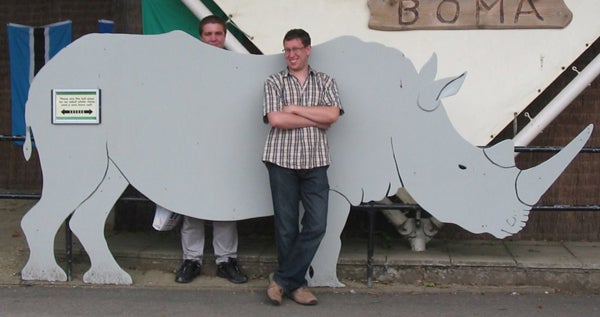
A reminder of how big a white rhino is - specifically, a southern white rhino. A wooden installation that used to be on show at Marwell Wildlife, UK. Credit: Darren Naish
Until recently, the consensus view was that white rhinos are one species (Ceratotherium simum), consisting of two subspecies: C. simum simum in the south of Africa, and C. simum cottoni in ‘the north’ (by which I mean – historically – Uganda, South Sudan, Democratic Republic of Congo, Chad and Central African Republic). The two can be distinguished in virtually all measurements (pertaining to skull and tooth dimensions, limb bone lengths and so on), southern white rhinos are generally larger (males can be 2000-2400 kg as opposed to 1400-1600 kg), longer-bodied, have a longer palate, more concave skull roof, and more prominent grooves between their ribs and around the tops of their limbs while northern white rhinos seemingly are longer-limbed, have a straighter back, smaller, lower-crowned teeth and a straighter skull roof (Groves et al. 2010). Southern white rhinos are also supposedly hairier on the body and ears. Genetic evidence indicates that the two forms diverged about 1 million years ago (Groves et al. 2010); more specifically, between 750,000 and 1.5 million years ago. There are also reported differences between the two in behaviour and vocalisation.
On supporting science journalism
If you're enjoying this article, consider supporting our award-winning journalism by subscribing. By purchasing a subscription you are helping to ensure the future of impactful stories about the discoveries and ideas shaping our world today.
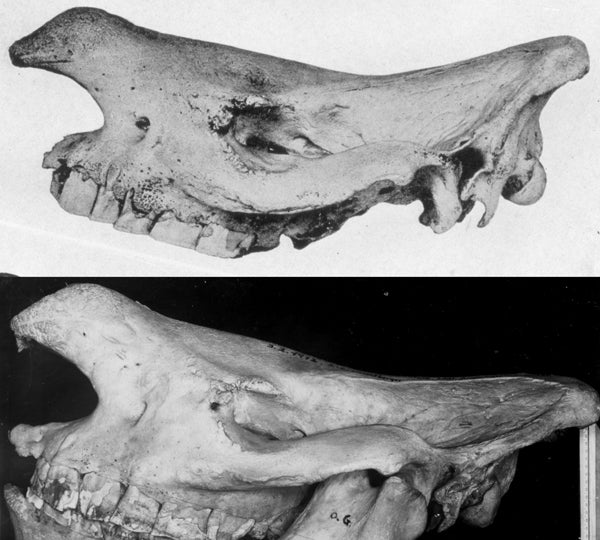
White rhino skulls compared: southern above, northern below. Note the more concave dorsal outline in the southern rhino. Credit: Groves et al. 2010
The overall conclusion from the study cataloguing these differences (Groves et al. 2010) is that this level of difference is more than we can expect for ‘subspecies’ of the same one species, and that we’re seeing enough difference – both in morphological and molecular data – for a species-level difference, the existence of these two distinct Ceratotherium lineages meaning that “[u]nder the Phylogenetic Species Concept [PSC] (the only objective concept applicable to allopatric forms), we have no option but to consider them specifically distinct” (Groves et al. 2010, p. 12).
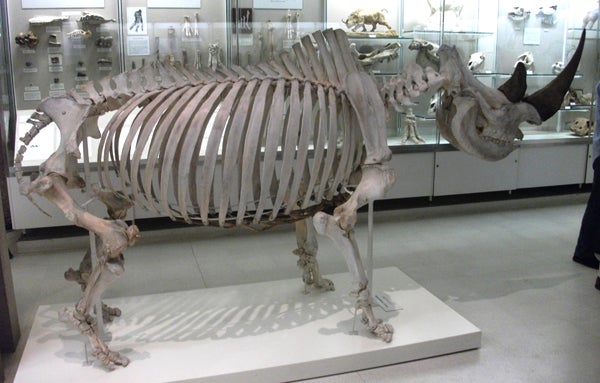
White rhino skeleton on display at the Cambridge Museum of Zoology in 2010. Note the tall neural spines over the shoulder. Credit: Darren Naish
I wrote about this proposal back in 2010, and said that it would likely come under fire as unwarranted splitting, as have a great many of the taxonomic proposals made by Colin Groves and his colleagues. There has been a minor push in the literature to get the near-extinct Northern white rhino to be termed the Nile rhinoceros but, other than that, how has separate species status for cottoni fared since 2010?
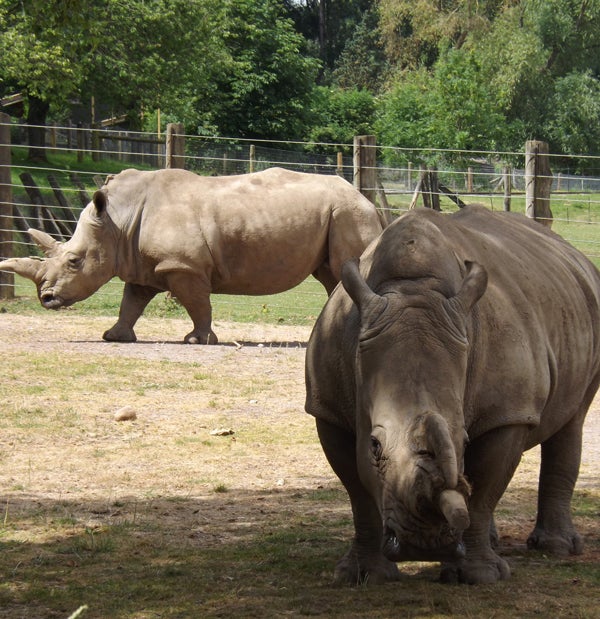
Southern white rhinos in captivity, at Marwell Wildlife, England. Credit: Darren Naish
On taxonomic inflation. The responses to splittings of this sort include, variously, that (1) the split has only been made for conservation-mitigated reasons (Isaac et al. 2004), (2) that the evidence for the split is weak and even a bit of a joke when it comes to sample size (Heller et al. 2013), (3) that the variation concerned is trivial (Heller et al. 2013) and easily accommodated within a species, (4) that the PSC underlying these decisions is problematic and inconsistent (Zachos et al. 2013, Zachos 2014), and that a biological species definition is better and justified by hybridisation data anyway, and (5) that the split is inconvenient and irksome, and merely symptomatic of a rash ‘taxonomic inflation’ phase (Meiri & Mace 2007)… who needs 58 bushbuck species when 1 species with 58 subspecies does the job just as well?
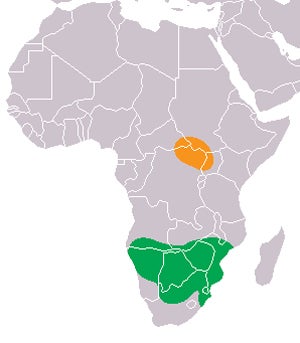
Map showing historical ranges of the two white rhino taxa, though Ceratotherium was, of course, far more widely distributed in the geological past. Credit: Fabio b Wikimedia (CC BY-SA 2.5)
As, of course, we all know, this is the issue that just won’t go away. I tend to be ambivalent about all the recently proposed splits in extant mega-mammals – take it or leave it, to be frank – but I mostly find the case for splitting to be pretty good. The populations concerned are often at least as distinct as other species that are universally regarded as ‘good’, and the fact that we tend not to regard them as species in the first place is due to a mid-20th century phase of mass laissez-fair lumping and taxonomic inertia more than to actual analysis (many of the populations concerned were described as distinct species, then uncritically lumped in a few influential reviews due to the existence of hybrid and intermediate populations, and then assumed thereafter to be part of a single super-variable species).
One could, of course, write a whole essay on this issue; I’m trying to avoid doing so here, and I’d point those interested to Gippoliti et al. (2017) for a modern critique of the taxonomic inflation argument. They argue that ‘taxonomic inflation’ is an unfair term given the positive taxonomic neglect that has afflicted the animals concerned and show how, time and time again, taxa have suffered – both as subjects of conservation and management priority, and via the consequences of outbreeding depression in captivity – from a lack of research and from a priori assumptions.
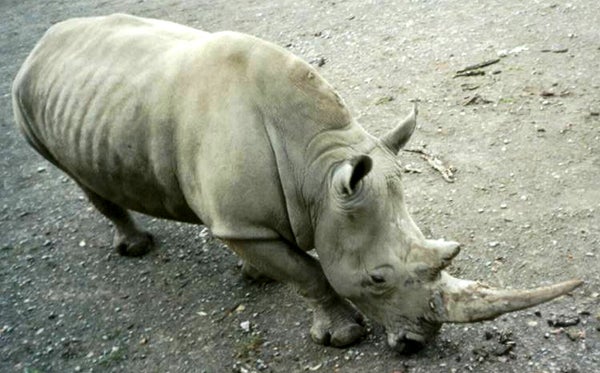
Southern white rhino at Marwell Wildlife, photographed c 2003. Credit: Darren Naish
Back to the rhinos. Southern white rhinos are relatively abundant (there are over 20,000), but very much the opposite is, sadly, the case for their northern cousins: they’re now down to just three individuals, one of which is the daughter of the lone surviving male. The proposal that northern and southern rhinos might be distinct species has been deemed problematic because crossing species for the purposes of conservation is generally not deemed acceptable, yet hybridisation presumably must occur if we want northern rhinos to persist.
With this issue very much in mind, Harley et al. (2016) examined the mitochondrial genomes of both northern and southern rhinos. Their conclusion? That the divergence time favoured by Groves et al. (2010) might be quite wrong, and that divergence might really have happened as recently as 200,000 years ago. They argued that this was more consistent with a subspecific designation than a specific one and went on to argue that hybridisation efforts should continue – even though they haven’t been successful so far (there was a northern x southern hybrid – an animal, named Nasi, euthanised in 2007 at age 30 – but she suffered poor health. The implication exists that her health and premature death were a consequence of her hybrid nature).
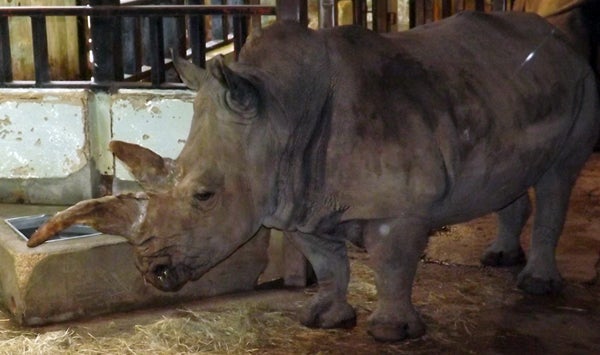
Funnily enough, all my photos are of southern white rhinos. This is Kiri: she is about 31 years old and moved to Marwell in 1988 from Whipsnade. Credit: Darren Naish
Is that the end of it then? No: the latest take on the white rhino issue has just been published in a review article by Groves et al. (2017). Harley et al.’s (2016) data is great, they say, but it seems to show both rhino taxa as reciprocally monophyletic (an observation that could be consistent with distinct species status). Furthermore, Harley et al. (2016) invoked comparisons with hominin populations that seem to have diverged within the same time range as that inferred for the rhinos. But – problem! – Harley et al. (2016) regarded the hominins concerned (Neanderthals and Denisovans) “as subspecies of H. sapiens” (p. 1288). There certainly might be people who hold that latter view, but it isn’t the ‘consensus’ view, nor one consistent with the way in which the evidence is currently interpreted. Hominin phylogeny and taxonomy may or may not be relevant to decisions made about rhinos, but the hominins concerned do not provide evidence against the view that a c 200,000 year divergence is inconsistent with a species-level split: there are plenty of species-level divergences that are this old (or young)*, or younger (note that our species is currently thought to be around 300,000 years old based on recently discovered material from Morocco).
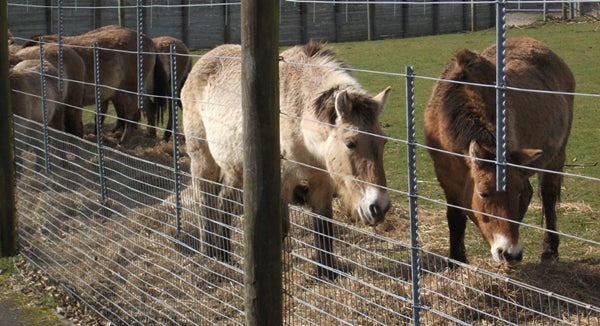
Captive Przewalski’s horses. This picture included so that the article does not consist of rhino photos alone. Credit: Darren Naish
* The divergences concerned do not involve mega-mammals, but such groups as cichlids, sticklebacks and ambystomatid salamanders. Domestic and Przewalski’s horses appear to have diverged within the last 100,000 years but this is arguably not analogous to the situation with the rhinos.
Having said that... if the reported c 200,000 year split for the rhinos is correct, it does count against separate species status. Perissodactyls in general appear to be slow evolvers, and I’m certainly sceptical of the idea that selection pressures operated as rapidly in rhinos as they did in the cichlids and the other animals just listed above.
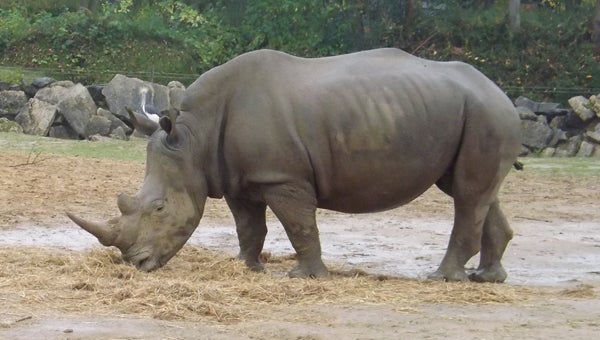
White rhino at Colchester Zoo (with crowned crane in the background), October 2017. Credit: Darren Naish
A proposal on what to do. In the end, we might be at an impasse. There will continue to be biologists who argue that the splittings and revisions advocated by Groves and colleagues are poorly founded and based on a problematic underlying philosophy. Yet there also, undoubtedly, remains the fact that these decisions are based on evidence consistent with the recognition of some kind of distinctiveness.
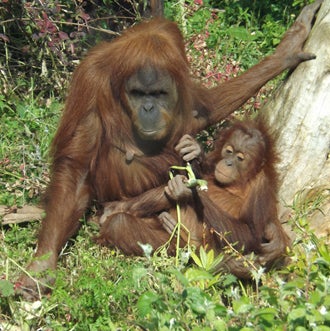
This is not an article about orangutans, but hopefully you appreciate the relevance. Credit: Darren Naish
And therein lies the great problem. Is a ‘distinctive’ population merely ‘just another population’, is it a ‘subspecies’ of a recognised species, or does it really warrant naming as a ‘species’? Given that 147 different species concepts haven’t gotten us anywhere apart from into a lot more arguments, I propose that something needs to be done: specialists urgently need to sit down together and agree on some sort of ‘distance metric’ (based on a given percentage of genetic variation, a given estimated divergence date or a given number of morphological differences) that allows us to agree on ‘how much difference’ warrants recognition as a species. So, go on, get to work. All I ask is for co-authorship and the recognition of intellectual property.
And I wrote this whole article without once mentioning orangutans. Rhinos have been discussed on Tet Zoo quite a few times over the years. See…
How did the White rhino get its name? Not how you think (even if you’re very clever)
On World Rhino Day 2015, Some Things about Rhinos You Might Not Know
Refs - -
Gippoliti, S., Cotterill, F. P. D., Zinner, D. & Groves, C. P. 2017. Impacts of taxonomic inertia for the conservation of African ungulate diversity: an overview. Biological Reviews doi: 10.1111/brv.12335
Groves, C. P., Cotterill, F. P. D., Gippoliti, S., Robovský, J., Roos, C., Taylor, P. J. & Zinner, D. 2017. Species definitions and conservation: a review and case studies from African mammals. Conservation Genetics doi: 10.1007/s10592-017-0976-0
Harley, E. H., de Waal, M., Murray, S. & O’Ryan, C. 2016. Comparison of whole mitochondrial genome sequences of northern and southern white rhinoceroses (Ceratotherium simum): the conservation consequences of species definition. Conservation Genetics 17, 1285-1291.
Heller, R., Frandsen, P., Lorenzen, E. D. & Siegismund, H. R. 2013. Are there really twice as many bovid species as we thought? Systematic Biology 62, 490-493.
Isaac, N. J. B., Mallet, J. & Mace, G. M., 2004. Taxonomic inflation: its influence on macroecology and conservation. Trends in Ecology and Evolution 19, 464-469.
Meiri S. & Mace G. M. 2007. New taxonomy and the origin of species. PLoS Biology 5 (7): e194.
Zachos, F. E. 2014. Commentary on taxonomic inflation, species delimitation and classification in Ruminantia. Zitteliana B 32, 213-216.
Zachos, F. E., Apollonio, M., Barmann, E. V., Festa-Bianchet, M., Göhlich, U., Habel, J. C., Haring, E., Kruckenhauser, L., Lovari, S., McDevitt, A. D., Pertoldi, C., Rössner, G. E., Sánchez-Villagra, M. R., Scandura, M. & Suchentrunk F., 2013. Species inflation and taxonomic artefacts – a critical comment on recent trends in mammalian classification. Mammalian Biology 78, 1-6.